Latest News
Temples and Deities
Hinduism, the world's oldest religion predates the recorded history .The antiquity of temples cannot be determined easily. Some idols with silas - which are made out of rocks - are geologically related to pre Cambrian age, which is 600 million years. The legends date back to "threthaa-yuga" - a million years ago (the seventh incarnation of lord Mahavishnu - Sree Rama) and later Sree Krishna of "dwaapara - yuga" (the nineth incarnation). Lord Parasurama, an immortal, established 108 Siva temples, 108 Durga temples, 108 Sastha temples and few no: Vaishnavite temples in the western coast of south India. He divided erstwhile kerala in to 64 grammas (domains) and classified the temples in to "gramadevatha" "grama Nathan". Even the boundaries are marked and security was rested up on some deities like "Sastha" (yodha). Later temples were installed as family temples (Tutelary deity)/ dharmadevatha (deity of the region/domains). There are mentions about the existence of a no: of temples in the closing part of "dwaapara - yuga". The history of temples for next 3000 years is not clear.
However the last 2000 odd years gives somewhat reliable data. Thanks to the contributions of Adi Sankara (788-820 A.D) which gave the revival of Hinduism in the right perspective. The temples were renovated / constructed during this time and the temple rites were systemized. Even method of worship was modulated in to the right direction. The invasion of Buddhism and Jainism to Kerala made some changes in construction of the temples & few rituals. Adi Sankara doctrine is practiced ever since with minor changes.
Schools of worship: are Saaktheya (goddess Sakthi), Saiva (Lord Pramasiva), Vaishnava(Lord Vishnu), Naga (serpent), Ganapathyam (Lord Vigeneswara), Kaumaram(subramanniya) and Saura (Sun). The last 3 mode of worship is not popular in Kerala.
Saaktheya Worship: is the oldest form of worship and supposed to possess supernatural or magical faculties. Saaktheya form of Hinduism is equipped with vast mythological personnel of its own which includes an immense array of female personalities. Adi - paraasakthy (primeval power) or Mahaamaaya is the supreme and the powers and actions of all deities depend on her will. She has different bhaavas (characters) both gentle and fierce.
Saivite worship Sakthi as Durga, Parameswary, Parvathy, Bhadrakali etc. Vaishnavite as Mahalakshmi and Brahma followers as Saraswathi, Brahmani, Gayathri etc. However in Kerala the devotees worship Sakthi in all forms and generally termed as "Bhagavathy" temples.
Vaishnavite worship: The immigrant Brahmins introduced this form. The most popular divinities are Mahavishnu, Narsimha and lord Krishna. In standing pose the beautiful Mahavishnu idols is having Sankhu (conch - Paanchajanyam) Chakra (disc-sudarsana / vajranaabha) Gada (kaumodaki) and Padma (lotus). Narasimha is popular with tulu Brahmins and Lord Sreekrishna is worshipped as Vishnu / Krishna (most popular forms).
Saivite worship: is a combination of Saketheya and Vaishanava. The lord Mahadeva is possessing immense power of the whole universe to procreate (srishti), sustenance (sthithi) and destruction (samhara). The idol - Siva linga - is in thaamas bhava. Siva linga is only a symbolic representation not a genital part. There are almost 3 equal parts to the idol. The bottom part - square - represents Lord Brahma, middle part - octagonal - represents Vishnu and the top part - circular - Siva(only the circular part is visible since octagonal part is within the "peetam" and the square part is still below). With inseparable powers of Sakthi, Siva turns the power center of the universe.
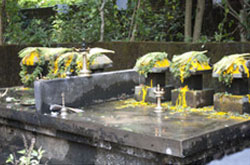
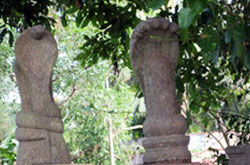
Naga worship: The temple for Naga (serpent) is called "Nagathara". There were 15,000 odd "Serppakavu's" (sacred grove) in kerala .It is a mini forest and the prathishta is done on chitrakoodam (stone-basement) The popular prathishta is Nagaraja (Anantha / Vasuki) with Naga-Yakshi(Lady - Serpent). Nagaraja idol will have a shape of coiled serpent with a raised hood. Erstwhile kerala is known as "Ahibhoomi" (the land of Serpents). This the oldest form of idol worship is connected to serpentine power ("Kundalini Sakthi") which is the rock bottom of all the energies and power of action inherent in a human being. At the basal region of the vertebral column at the mid spot between anus and penis is the resting place of the Kundalini Sakhti. This very powerful energy lies here dormant as a snake having three and half coils. Generally Naga worship is to ensure progeny and prosperity of the family.
Deities: The deities include a vast spectrum based on different kalpas (sacred percepts) which is having a no: of sankalpas (splendid conceptions - at the time of consecration). For example in the Vaishnavite kalpa Lord Vishnu is worshipped as Mahavishnu as in ananthasayanam, Dhanwanthari moorthi, Sudarsana chakram and of course as in ten incarnation.
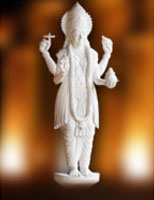
Sakthi: Devi of gentle nature - as Thripurasundari, Parameswary, Mahalakshmi, Saraswathi, Jagdambika etc. As goddess of fierce: Kaali, Mahishasuramardhini etc And as Sapthamathrukkal
Siva: As Mahadeva, Dkhashina moorthi, Rudra, Mahalingeswara, Panchalingeswara, kirathamoorthy are sankalpas at the time of installation. These are few among 1008 sankalpas in "Sivapuranam".
Vettakkorumakan, Veerabhadran, keshethrapalan are some other form of Siva deities.
There is combination of kalpas: Sankaranarayana, Ardhanareeswara, etc
Spirit cults: totemistic (Pillay, Chamundi etc), royal (Raktheswari, Mariyamma etc) ferocious and Bharmaraksas etc. And finally Tutelary deity of the family.
Vettakkorumakan: The son of Siva in Parvathy when they were living in disguise as Kiartha Moorthi (Vettakkaran) and Kirathi. This deity is installed near grama chieftain, since it is a war god with bow and arrow/ dragger.
Veerabhadra: In the puranas - vayu, Mahabaradha - Veerabhadra is the son of Siva. In Devi Bagavatham the birth is connected to Daksha yaga. Hearing the tragic suicide of Sree Parvathy, Siva beats his Jada (matted hair) on ground and Veera Bhadra along with Bhadrakali is emerged. This version is most accepted in kerala. As Veerabhadra was born from "Vaira" (vengeance), he is also called Vairajatha.
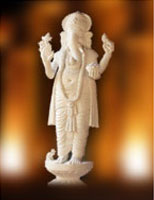
Lord Ganapathy: Normally installed as a sub - deity. All pooja should start with an offering to Ganapathy. In Vadakunnathan temple at Thrissur the "Udayaasthamana pooja" is done at Ganapathy temple. The full lot of Appam (made out of 13 kg rice) is offered to Ganapathy only. Created by Devi Parvath as a personnel guard and was beheaded by none other than Lord Pramasiva by mistake, Ganapathy was given rebirth jointly by Brama, Vishnu & Maheswara. During the process, the lost head was replaced with a tusker's head (readily available one) - as per the legend. The idol has a head of an elephant (Gajaanana), a full belly (lambodara) one tusk (eka-danda), twisted trunk (vakrathunda) sacred tread and the crown. Normally the Ganapathy idols are in sitting pose. Worshipped in 24 sankalpas Ganapathy idols also there in standing pose, dancing pose etc. If Ganapathy is the main deity then the sub deity will be either Durga or Siva. The lord has two consorts Sidha & budhi.
Lord Subramanniya: This south Indian deity is worshipped in various sankalpa viz Skanda (of Parvathy), kumara (of Ganga), karthikeya (of krithikas), Saravana (of saravana plant) etc. Of these Skanda is most popular.
Lord Sastha and Ayyapa: Sastha worship dates back early centuries and believed to be the combination of knowledge (jnana) of Lord Siva and Charm of Lord Vishnu. The idol is installed in a single base with both of the wives Poorna & Puskala on either side. Another type is with wife Sreeprabha and son Sree Sathyaka. Lord Ayyappa is another branch of worship called "Aryaka Sastha" where Lord Ayyapa is a Bal yogi / brahmachaari.
Ardhanareeswara: This innovative concept of Hindu purana was the fundamental of Advaita philosophy developed by saint Adi Sankara. In a joyous mood Sree Parvathy closed three eyes of Pramasiva and whole universe turned stand still(three eyes are Sun, Moon and Fire). The embodiment of love Sree Parvathy was sentenced to do service in the earth to up lift Dharma. On her divine mission to earth few worshiping places were identified like Kanchi kameswary etc. Finally Sree Parvathy informed the almighty that she can't live separately. Sree Parvathy was afraid to the core, she may commit some stupid mistake if left alone and requested to be part and parcel of his body. That is how the concept of Ardhanareeswara (half Siva and half Devi) was developed.
Lord Sankaranarayana: the idols may be either in "linga" form or as figurines. In the latter the right side will be jata with crescent and three eyes (the third eye partly) while the left side represents Vishnu characters like crown and conch.
Spirit Cult: This primitive worship of semi-divine spirits are considered as upholders of righteousness.
Totemistic: are originated from boar, tiger and bull. The Nandi or Nandikeswara is one among them. The divine bull of Lord Siva is the guardian from evil spirit and wicked people. This speechless deity is supposed to be the author of Kama sutra. Saint Vatsyayana is the incarnation of "Nandi" as per one version. Other version portraits Vatsyayana as the student of Nandi. The devotees are supposed to submit their complaints, wishes to Nandi who will convey to Siva at appropriate time.
Royal: Mariyamma, Kshetrapalan etc who are worshipped in normal style.
Ferocious: are in two types. The spirit of those who met tragic death due to social in justice and the second type is associated with black magic. Gulika, son of Saturn is one among them, who has no form and it is sankalpa prathishta. Kuttichathan, widely worshipped deity is from "Panchamoorthy" concept and is from "kushhikalpa" doctrine.
There are innumerable deities in sprit worship and the popular one is Bramharakshass. It is considered to be the spirit of Brahmin, mostly priest or so connected to particular temple.
Navagraha: Some temple they are installed as sub shrine at the north - east corner and the norm is as follows - north to south rotation.
Eastern row - Both Buddha (Mercury) and Sukra (Venus) is facing east and Chandra (moon) facing west.
Central row - Brhaspathi (Jupiter) to north, Adithya (Sun) to east and Kuja (Mars) facing south.
Western row - Both Rahu and Kethu (dragon's tail & head) facing south and finally Sani (Saturn) facing west.
Sapthamathrukkal: The seven mothers with the invisible presence of the Mahamaya is installed on a single granite stone on the inner balivattom at left hand side of the main shrine and parallel to the sreekovil. Lord Ganapathy and veerabdra will be installed perpendicular to the row. The order is from east to west, veerabhadra, bhraami, maheswari, kaumari, Vaishnavi, varahi, Indrani, Chamundi and Ganapathy.
As an independent Sapthamatha temple the tantric styles are Darujiththvidhanam and Rurujiththvidhanam. The former is common.
The latter version Siva and kshethrapala is to be installed. Lord Siva will be installed facing east. Another temple will be constructed facing east or west and Chamundadevi will be installed. Adjacent to one of these temples Sapthamathrukkal will be installed facing north. All the poojas are done on a peetam centrally located in front of the row. There are few temples which are exclusively for saptha mathrukkal where Siva prathishta will be separate. The Chamunda will be in the center of the row in chamundeswary temple.
Kshetrapalan: The latter version Siva and kshethrapala is to be installed.Lord Siva will be installed facing east. Another temple will be constructed facing east or west and Chamundadevi will be installed. Adjacent to one of these temples Sapthamathrukkal will be installed facing north. All the poojas are done on a peetam centrally located in front of the row. There are few temples which are exclusively for saptha mathrukkal where Siva prathishta will be separate.The Chamunda will be in the center of the row in Chamundeswary temple.
Temple Architecture
The consecration of a temple is a lengthy process with out any room for compromise.
A) Achatyavaranam: The foremost step is to adopt a thanthri for the temple.A person considered for thanthri should be well versed in six saashtras (sika, kalpam, niruktham,vyaakaranam, jyothisham and chandas) to recite veda manthras in clarity, correct intonation etc. Besides he must follow the shodasopacharaas and shodasasamskaras. The rigorous training under a teacher (guru)is required to develop inner strength and ability to create and transform the divine energy.
B) Bhoo parigraha (find suitable place): Tantra sastra gives clear cut norms to select the place.The ambience and the topography are clearly defined.
C) Vasthu pooja: The land is to be prepared for construction .With the permission of the intended deity all sprits good or bad should be released from the soil with compensation. After that the ground is plowed cereals and pulses are germinated. Finally cows are allowed eat this. The architecture of installing the idol is based on Kundalini Sakthi or Serpent/ serpentine power. The divine power is polarized in to static and dynamic form. The static is an infinite pool of energy which is sleeping in the bottom (Kundalini). This is to be awakened through dynamic actions. Shadaadara pratisha concept is the analogic representation to awaken this supreme power.
Shadadwara prathishta: (Six step consecration)
1) "Moolladharam" (foundation stone) represents earth. A square piece of granite is placed in the foundation.
2) "Swathishtanam": represents water. On the center of the foundation stone a half moon type stone is placed with cereals.
3) "Manipoorakam": (Nidhi kumbham) represents Agni(fire) A pot filled with diamonds are placed over the swathistanam
4) "Anahatham": represents air An eight petal lotus with different metals is placed over the nidhikumbham. On the top of this a tortoise made out of five metals are placed this is called Pranapratheeakam. The tortoise should face exactly like the deity.
5) Visudhi is a stalk (yoganala) which reaches the floor level.
6) Aanjaa chakra. The stalk touches this sila (granite).
This sila will have eight hole in eight directions which will be filled with cereals, diamonds etc to develop 8 fundamental virtues. There will be a hole in the center where the idol with peetam will be installed.
Architecture of Temple
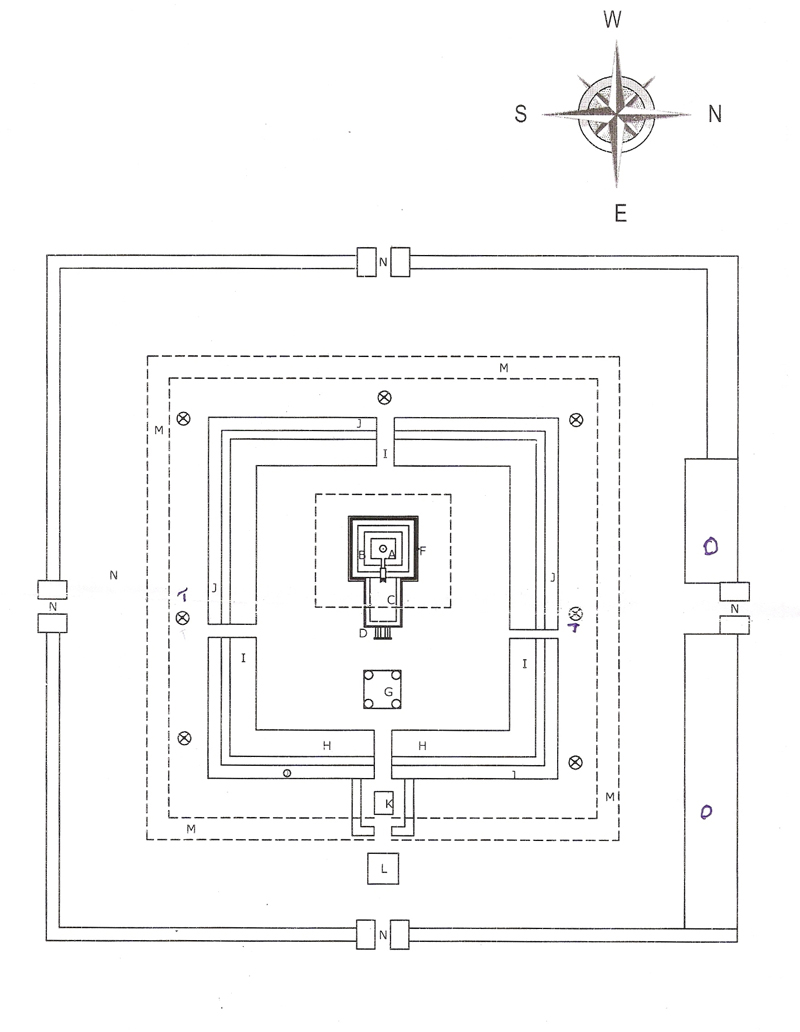
| A) SreeKovil | B) Antharalam | C) Mukamandapam | D) Sopanam |
| F) Pranalam | G) Namskaramandapam | H) Valiyambalam | I) Nalambalam |
| J) Vilakkumadom | K) Valiya Balikkallu | L) Flag post | M) Anthar-mandalam |
| N) Gopuram | O) Oottupura/agrasala | P) Balipeetoms |
The sanctum Santorum: or the sreekovil is the most important part of a temple. The temples of gentle sankalpa should face towards the grama and that of fierce should face outwards. The sreekovil are generally shaped as square, rectangular, circular, elliptical (oval) and apsidal. But inside the sreekovil the gharbha griha should be square. There are inner chamber and outer chamber and in-between an ambulatory passage. An imaginary square portion is set apart for consecration, when the sreekovil is a single chamber.
Sree Kovils are classified in to three. Single - storied, double - storied and three - storied. The walls will have ghanadwaraas, panjaras, bracket etc. besides the carvings of the deity or mural painting based on the puranas. The sthoopika or thazhikakudom which having four parts is an integral part of sreekovil. The sthoopika will have eight petalled lotus (mahapadmam) as base, pot (kumbhom), lotus stalk (naalam) and lotus-bud (kuta-maala) in the top. It is assumed that thazhikakudom transmits the divine energy. The ganadhawaraas are closed shutters which acts as a heat exchanger.
The Sreekovil will have an extension "mukha-mandapam". This may be often pillared or walled hall open or closed.
Sopaanam is the entrance to sreekovil which is direct entry or lateral with flight. The banisters are vyaali - mukham with rolling tongues. On either side of the main entrance dwaarapalas / dwaarapalikas (guards) will be there.
Another important part of the sreekovil is ovu or water chute (pranaalam). With vyaali mukham at base there are different shapes to pranalam. Some of them are supported by figurines.
Sreekovil and sopanam are called inner balivattom (inner-most praakaram)
Positions of Balipeetoms
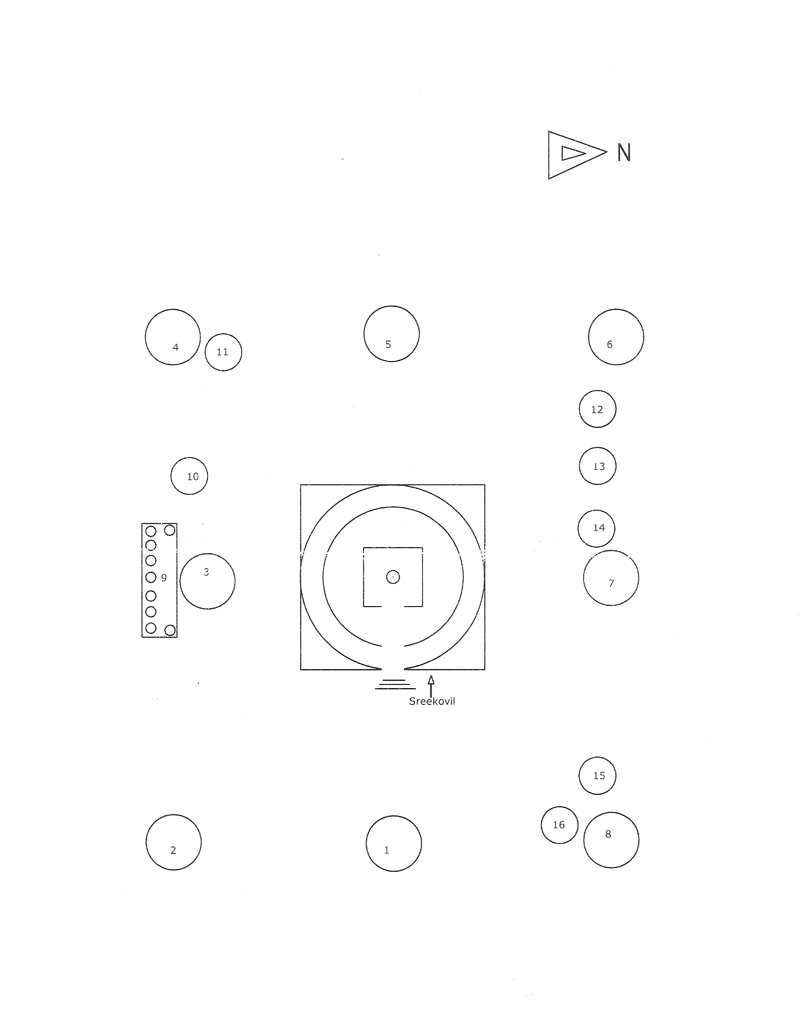
Positions of Balipeetoms - Anthar - mandalam
1) Indra
2) Agni
3) Yama
4) Nrthi
5) Varuna
6) Vayu
7) Surya
8) Siva (Isaana)
9) Sapthamathrukkal
10) Sastha
11) Anantha
12) Durga
13) Subramannya
14) Kubera
15) Nirmalyadhari
16) Brahma.
Anthar-mandalam is an imaginary square around the sreekovil, (nearly 1.4 meters from the center of the sreekovil) where Ashta dikpalakas (presiding guardian divinities at eight points-soma at north, eesana at north - east indra at east, agni south - east, yama at south, nrthi at south - west, varuna at west and vayu at north - west) and balipeedams for brama at north east anantha at south west, Sastha between south and south west, durga, subramanniya, kubera in a row more or less equidistant between vayu and soma and nirmaladhari near to eesana are installed.
Sapthamatrakkal with genesa and veerabhadra is installed adjacent to yama at south. The deities installed at north will face south, south will face north east will face west and west will face east. Only one balipeetom is installed in some temple either in south east (Agni cone) or north west (vayu cone). Namaskara mandapam is a detached structure seen on most of the vaishnavite and Saivite temples. Normally square in shape with four pillars (rarely 16 pillars), and but definitely less in total height of the sreekovil. The motif will decorate the pillars and the ceilings will have carvings of Navagraha or ashtadikpalas. Namaskaramandapam is meant for kalasapooja mainly. Siva temples the idol of Nandi will be installed in front of the main entrance slightly deviated from the center line of the garbha-dwara. All namaskaramandapams there is an invisible presence of the dearest to the deity on this spot and advised not to trespass (as restricted in Siva temple). In Bhadrakali temples a rectangular long pillared hall known as pattupura is common instead of namaskaramandapam. Here kalaezhuthupattu is performed. This the first "prakara" in pachaprakara termed as akathebalivattom
2) Antha-haara or chuttambalam: The front portionwith greater width is known as valiyambalam. This place is used to perform temple rituals like "kalamezhuthu" and arts like "chakyarkoothu", "ottamthullal" etc. Some big temples this front portion is double storied. The other three sides are called Nalambalam where the tidappilly, store, mulayara etc are functioned.
3) Madhya-ahara: the third parakaram is called as "vilakkumaatam" (galaxy of lamps). It is a separate structure outer to antha - haraa with an ambulatory passage. If the lamps are placed on the walls of chuttambalam; it is not treated as Madhyahara.
4) Bhahya-aharaa or outer balivattom is the place for outer circumambulatory path (prathakshinavazhi) principal oblation stone (valiyabalikallu), balivattom for ganadevathas (9 set of divinities, always travelling as a group, 12 adithyas, ashatavasus, 11 rudras etc.), Kshetrapalan, flag post, koothambalam etc.
5) Maryadha-ahara or outer wall is the place for gopuram, annadhanamandapam etc. General note to "pancha-praaharaa" The total area of the temple will be 15 times the area of the sreekovil. Gopuram and wall may be constructed in all five places, which are called dhwara shobha, dhwarasala, dhwaraprasadam, dhwaraharmyam and dhwaragopuram. In kerala it is customary to build gopuram on dhwaragopuram, the final stage. Shadaadara concept of consecration is the fundamental principal of installing the deity. Based on Kundalini Sakthi the six steps are enlarged to 14 tiers vertically and the 14th tier will be base of the idol. Same steps are followed in Valiya Balikkallu The Dhwaja-sthambha (flag post) is installed in the same manner and tantric ritual of idol consecration. In bhayakara the ganadevathas balikallu is mandatory only when the valaiyabalikallu is present.
The nirmaladhari is the guard of the idol, which maybe In the form of linga, peetam and rarely figurine. According to the principal deity the name differs. Chadeswarn for lord Siva, chandsenan for Vishnu, mundini for durga etc. Thidappaly is constructed at nalambalam in south west (agni - cone) normally and in some special case on North West (vayu - cone). Rarely thidappally is built as a separate structure outside the chuttambalam. Mulayara is in north chuttambalam where specified pulses and cereals are germinated during for utsava - bali. The temple well should be at north east corner close to northern nalamblam. The position of sub - deity is very important. Sub deity temples installed parallel to main shrine; the sub deity should face as the same direction of the principal deity. If the sub shrine is in front of main temple, the sub deity should face the main deity. If the sub deity is behind but in the same sreekovil it should face opposite, naturally. This rules have got exemption in some special consecrations.
Main References:
Temples of kerala - S. Jayashankar,
Hindu Encyclopedia - Acharya Narendrabhushan.
Mahakshetrangalkkumunnil - Nalakkal
Kshetravijnanakosam - P.G.Rajendran
Anushtana vijnakosam - Dr.K.Balakrishna varier
Eythihya mala - Kottarthil Sankunny
